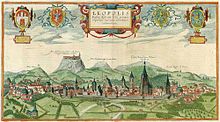Royal city in Polish–Lithuanian Commonwealth

In the history of Poland, a royal city or royal town (Polish: miasto królewskie) was an urban settlement within the crown lands (Polish: królewszczyzna).[1]
The most influential royal cities enjoyed voting rights during the free election period in Poland (1572-1791). These cities were Gdańsk, Warsaw, Kraków, Poznań, Lwów, Wilno, Toruń, Lublin, Kamieniec Podolski and Elbląg.
Law on the Cities
On April 18, 1791, the Great Sejm adopted the Free Royal Cities Act (full title: "Miasta nasze królewskie wolne w państwach Rzeczypospolitej" - "Our Free Royal Cities in the States of the Commonwealth"), included as Article III into the Constitution of May 3, 1791.
The law granted a number of privileges for the residents of royal cities. Many of these privileges and rights have already been enjoyed by major royal cities, and the law effectively equalized all royal cities in this respect. It also includes some rights earlier enjoyed only by szlachta.
Royal cities by region



Greater Poland Province
- Babimost
- Bielsk
- Błonie
- Bolesławiec
- Bolimów
- Brdów
- Brześć Kujawski
- Budzyń
- Chorzele
- Ciechanów
- Czersk
- Człopa
- Dobrzyń nad Wisłą
- Elbląg
- Gąbin
- Gdańsk
- Gniezno
- Gostynin
- Kalisz
- Kłecko
- Kłodawa
- Kolno
- Koło
- Konin
- Kopanica
- Kościan
- Kowal
- Latowicz
- Liw
- Łęczyca
- Łomża
- Maków Mazowiecki
- Mława
- Mszczonów
- Nieszawa
- Nowogród
- Nur
- Odolanów
- Ostrołęka
- Ostrzeszów
- Piaseczno
- Piła
- Piotrków
- Płock
- Płońsk
- Pobiedziska
- Poznań
- Przasnysz
- Przedecz
- Pyzdry
- Radomsko
- Radziejów
- Radziłów
- Rawa
- Rogoźno
- Różan
- Rypin
- Serock
- Sieradz
- Sochaczew
- Sochocin
- Sompolno
- Stanisławów
- Stawiszyn
- Sulmierzyce
- Szadek
- Szczerców
- Śrem
- Środa Wielkopolska
- Toruń
- Tuszyn
- Warka
- Warszawa
- Warsaw New Town
- Warta
- Wieluń
- Wizna
- Wschowa
- Wyszogród
- Zakroczym
- Zambrów
- Zgierz





- Augustów
- Berezań (today part of Ukraine)
- Będzin
- Biecz
- Bielsk
- Bobrowica (today part of Ukraine)
- Bohusław (today part of Ukraine)
- Bracław (today part of Ukraine)
- Brańsk
- Chełm
- Czerkasy (today part of Ukraine)
- Chęciny
- Chmielnik
- Częstochowa
- Drohiczyn
- Dubienka
- Goniądz
- Hajsyn (today part of Ukraine)
- Kamieniec Podolski (today part of Ukraine)
- Kaniów (today part of Ukraine)
- Kazimierz
- Kazimierz Dolny
- Kęty
- Kijów (today part of Ukraine)
- Kleparz
- Kłobuck
- Knyszyn
- Koszyce
- Kowel (today part of Ukraine)
- Kozienice
- Kraków
- Krasnystaw
- Krzemieniec (today part of Ukraine)
- Krzepice
- Lelów
- Leżajsk
- Lityn (today part of Ukraine)
- Lubecz (today part of Ukraine)
- Lublin
- Lwów (today part of Ukraine)
- Łosice
- Łuck (today part of Ukraine)
- Łuków
- Mielnik
- Milanowicze (today part of Ukraine)
- Myrhorod (today part of Ukraine)
- Nowa Uszyca (today part of Ukraine)
- Nowy Korczyn
- Nowy Sącz
- Nowy Targ
- Olkusz
- Opoczno
- Owrucz (today part of Ukraine)
- Perejasław Chmielnicki (today part of Ukraine)
- Pierzchnica
- Pilzno
- Płoskirów (today part of Ukraine)
- Podgórze
- Połaniec
- Proszowice
- Przedbórz
- Przemyśl
- Radom
- Radoszyce
- Rajgród
- Ratno (today part of Ukraine)
- Ropczyce
- Sandomierz
- Słomniki
- Solec nad Wisłą
- Stężyca
- Stopnica
- Stryj (today part of Ukraine)
- Suraż
- Świniuchy (today part of Ukraine)
- Urzędów
- Wąwolnica
- Wieliczka
- Winnica (today part of Ukraine)
- Wiślica
- Włodzimierz Wołyński (today part of Ukraine)
- Wolbrom
- Wyszniwka (today part of Ukraine)
- Zwinogródka (today part of Ukraine)
- Zwoleń
- Żytomierz (today part of Ukraine)

- Brześć Litewski (today part of Belarus)
- Dzisna (today part of Belarus)
- Filipów
- Grodno (today part of Belarus)
- Kleck (today part of Belarus)
- Lida (today part of Belarus)
- Mińsk (today part of Belarus)
- Troki (today part of Lithuania)
- Wilno (today part of Lithuania)
- Wohyń
- Wołkowysk (today part of Belarus)
